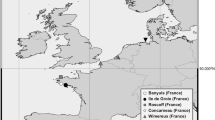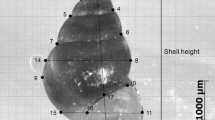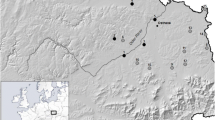Abstract
We review the spatial and temporal correlates of uniparental reproduction in freshwater snails as they pertain to the ecological hypotheses for the maintenance of biparental sex. The biogeographic evidence from two species (Potamopyrgus antipodarum andBulinus truncatus) presently supports the Red Queen hypothesis that biparental reproduction is selected as a way to reduce the risk to progeny of parasite attack. Uniparental reproduction in these species is associated with low levels of infection by parasites (castrating digenetic trematodes), suggesting that parthenogenesis or self-fertilization can replace cross-fertilization when the risk of infection is low. In addition, inB. truncatus, the opportunity for cross-fertilization coincides with the season in which parasite attack is highest. In a third species (Campeloma decisum), parthenogenetic reproduction is correlated with latitude and the presence of a non-castrating trematode that may prevent cross-fertilization; these patterns suggest that parthenogenesis has been selected as a mechanism to assure reproduction. Finally, we discuss the spotty taxonomic distribution of parthenogenetic species.
Similar content being viewed by others
References
Anderson, R. M., and May, R. M., Population biology of infectious diseases: Part I. Nature280 (1979) 361–366.
Anderson, R. M., and May, R. M., Prevalence of schistosome infections within molluscan populations: observed patterns and theoretical predictions. Parasitology79 (1979) 63–94.
Antonovics, J., and Ellstrand, N. C., Experimental studies of the evolutionary significance of sexual reproduction. I. A test of the frequency-dependent selection hypothesis. Evolution38 (1984) 103–115.
Beadle, L. C., The Inland Waters of Tropical Africa: An Introduction To Tropical Limnology. Longman, London 1974.
Bell, G., The Masterpiece of Nature: The Evolution and Genetics of Sexuality. University of California Press, Berkeley 1982.
Bernstein, H., Byerly, H. C., Hopf, F. A., and Michod, R. E., Genetic damage, mutation, and the evolution of sex. Science229 (1985) 1277–1281.
Betterton, C., Spatiotemporal distributional patterns ofBulinus rohlfsi (Clessin),Bulinus forskalii (Ehrenberg) andBulinus senegalensis (Muller) in newly-irrigated areas in northern Nigeria. J. moll. Stud.50 (1984) 137–152.
Bremermann, H. J., Sex and polymorphism as strategies in host-pathogen interactions. J. theor. Biol.87 (1980) 671–702.
Brown, D. S., Freshwater Snails of Africa and Their Medical Importance. Taylor and Francis, London 1980.
Brown, D. S., and Wright, C. A., On a polyploid complex of freshwater snails (Planorbidae:Bulinus) in Ethiopia. J. Zool., Lond.167 (1972) 97–132.
Bull, J. J., and Charnov, E. L., Enigmatic reptilian sex ratios. Evolution43 (1989) 1561–1566.
Burt, A., and Bell, G., Mammalian chiasma frequencies as a test of two theories of recombination. Nature326 (1987) 803–805.
Burt, A., and Bell, G., Seed reproduction is associated with a transient escape from parasite damage in American beech. Oikos61 (1991) 145–148.
Charlesworth, B., The cost of sex in relation to mating system. J. Theor. Biol.84 (1980) 655–671.
Charnov, E. L., and Bull, J. J., When is sex environmentally determined? Nature266 (1977) 828–830.
Clay, K., Differential establishment of seedlings from chasmogamous and cleistogamous flowers in the grass,Danthonia spicata. Oecologia36 (1983) 734–741.
Clay, K., and Antonovics, J., Demographic genetics of the grassDanthonia spicata: success of progeny from chasmogamous and cleistogamous flowers. Evolution39 (1985) 205–210.
Conover, D. O., and Heins, S. W., Adaptive variation in environmental and genetic sex determination in a fish. Nature326 (1987) 496–498.
Dybdahl, M., and Lively, C. M., Diverse endemic clones in mixed populations of a freshwater snail (Potamopyrgus antipodarum). J. evol. Biol. (1995) in press.
Eernisse, D. J., Reproductive patterns in six species of Lepidochitona (Mollusca: Polyplacophora) from the Pacific Coast of North America. Biol. Bull.174 (1988) 287–302.
Fisher, R. A., The Genetical Theory of Natural Selection. Oxford University Press, Oxford 1930.
Fryer, S. E., Oswald, R. C., Probert, A. J., and Runham, N. W., The effect ofSchistosoma haematobium infection on the growth and fecundity of three sympatric species of Bulinid snails. J. Parasit.76 (1990) 557–563.
Gadgil, M., and Bossert, W., Life history consequences of natural selection. Am. Nat.104 (1970) 1–24.
Geraerts, W. P. M., and Joosse, J., Freshwater snails (Basommatophora), in: The Mollusca, vol. 7, Reproduction, pp. 141–207. Eds A. S. Tompa, N. H. Verdonk and J. A. M. van den Biggelaar. Academic Press, Orlando 1984.
Gerritsen, J., Sex and parthenogenesis in sparse populations. Am. Nat.115 (1980) 718–742.
Ghiselin, M. T., The Economy of Nature and the Evolution of Sex. University of California Press, Berkeley 1974.
Hamilton, W. D., Sex versus non-sex versus parasite. Oikos35 (1980) 282–290.
Hamilton, W. D., Axelrod, R., and Ranese, R., Sexual reproduction as an adaptation to resist parasites (A Review) Proc. natl Acad. Sci. USA87 (1990) 3566–3573.
Heller, J., and Farstey, V., Sexual and parthenogenetic populations of the freshwater snailMelanoides tuberculata in Israel. Israel J. Zool.37 (1990) 75–87.
Holtsford, T. P., and Ellstrand, N. C., Inbreeding effects inClarkia tembloriensis (Onagraceae) populations with different natural outcrossing rates. Evolution44 (1990) 2031–2046.
Howard, R. S., and Lively, C. M., Parasitism, mutation accumulation and the maintenance of sex. Nature367 (1994) 554–557.
Jaenike, J., An hypothesis to account for the maintenance of sex within populations. Evol. Theory3 (1978) 191–194.
Jain, S. K., The evolution of inbreeding in plants. A. Rev. Ecol. Syst.7 (1976) 469–495.
Jarne, P., Finot, L., Bellec, C., and Delay, B., Aphally versus euphally in self-fertile hermaphrodite snails from the speciesBulinus truncatus (Pulmonata: Planorbidae). Am. Nat.139 (1992) 424–432.
Jarne, P., Vianey-Liaud, M., and Delay, B., Selfing and outcrossing in hermaphrodite freshwater gastropods (Basommatophora): where, when and why. Biol. J. Linn. Soc.49 (1993) 99–125.
Jelnes, J. E., Experimental taxonomy ofBulinus (Gastropoda: Planorbidae): the West and North African species reconsidered, based upon an electrophoretic study of several enzymes per individual. Zool. J. Linn. Soc.87 (1986) 1–26.
Johnson, S. G., Spontaneous and hybrid origins of parthenogenesis inCampeloma decisum (freshwater prosobranch snail). Heredity68 (1992) 253–261.
Johnson, S. G., Parasite-induced parthenogenesis in a freshwater snail: stable, persistent patterns of parasitism. Oecologia89 (1992) 533–541
Johnson, S. G., Parasitism, reproductive assurance and the evolution of reproductive mode in a freshwater snail. Proc. R. Soc. Lond. B255 (1994) 209–213.
Jokela, J., and Lively, C. M., Parasites, sex and early reproduction in a mixed population of freshwater snails. Evolution (1995) in press.
Jones, C. S., Okamura, B., and Noble, L. R., Parent and larval RAPD fingerprints reveal outcrossing in freshwater bryozoans. Molec. Ecol.3 (1994) 193–199.
Jordan, P., and Webbe, G., Schistosomiasis: Epidemiology, Treatment and Control. William Heinemann Medical Books Ltd., London 1982.
Kondrashov, A. S., Deleterious mutations and the evolution of sexual reproduction. Nature336 (1988) 435–440.
Lafferty, K. D., The marine snail,Cerithidea californica, matures at smaller sizes where parasitism is high. Oikos68 (1993) 3–11.
Larambergue, M. de, Etude de l'autofé condation chez les gastéropodes pulmoné/s: recherches sur l'aphallie et la fécondation chezBulinus (Isidora) contortus Michaud. Bull. biol. Fr. Belg.73 (1939) 19–231.
Law, R., Bradshaw, A. D., and Putwain, P. D., Optimal life histories under age-specific predation. Am. Nat.114 (1979) 339–417.
Levin, D. A., Pest pressure and recombination systems in plants. Am. Nat.109 (1975) 437–451.
Lively, C. M., Evidence from a New Zealand snail for the maintenance of sex by parasitism. Nature328 (1987) 519–521.
Lively, C. M., Adaptation by a parasitic trematode to local populations of its snail host. Evolution43 (1989) 1663–1671.
Lively, C. M., Parthenogenesis in a freshwater snail: reproductive assurance versus parasitic release. Evolution46 (1992) 907–913.
Lively, C. M., Craddock, C., and Vrijenhoek, R. C., Red Queen hypothesis supported by parasitism in sexual and clonal fish. Nature344 (1990) 864–866.
Lively, C. M., and Johnson, S. G., Brooding and the evolution of parthenogenesis: strategy models and evidence from aquatic invertebrates. Proc. R. Soc., Lond. B256 (1994) 89–95.
Lively, C. M., and Howard, R. S., Selection by parasites for clonal diversity and mixed mating. Phil. Trans. R. Soc., Lond.346 (1994) 271–281.
Lloyd, D. G., Some reproductive factors affecting the selection of self-fertilization in plants. Am. Nat.113 (1979) 67–79.
Lloyd, D. G., Benefits and handicaps of sexual reproduction. Evol. Biol.13 (1980) 69–111.
Lynch, M., Destabilizing hybridization, general-purpose genotypes and geographic parthenogenesis. Q. Rev. Biol.59 (1984) 257–290.
May, R. M., and Anderson, R. M., Population biology of infectious diseases: Part II. Nature280 (1979) 455–460.
Maynard Smith, J., The origin and maintenance of sex, in: Group Selection, pp. 163–175. Ed. G. C. Williams. Aldine Atherton, Chicago 1971.
Maynard Smith, J., The Evolution of Sex. Cambridge University Press, Cambridge 1978.
Maynard Smith, J., Evolutionary Genetics. Oxford University Press, Oxford 1989.
Michod, R. E., Evolution of life histories in response to age-specific mortality factors. Am. Nat.113 (1979) 531–550.
Mitchell-Olds, T., and Waller, D. M., Relative performance of selfed and outcrossed progeny inImpatiens capensis. Evolution39 (1985) 533–544.
Mitter, C., Futuyma, D. J., Schneider, J. C., and Hare, J. D., Genetic variation and host plant relations in a parthenogenetic moth. Evolution33 (1979) 777–790.
Moritz, C., McCallum, H., Donnellan, S., and Roberts, J. D., Parasite loads in parthenogenetic and sexual lizards (Heteronotia binoei): support for the Red Queen hypothesis. Proc. R. Soc. Lond. B244 (1991) 145–149.
Muller, H. J., The relation of recombination to mutational advance. Mutat. Res.1 (1964) 2–9.
Nagylaki, T., A model for the evolution of self-fertilization and vegetative reproduction. J. theor. Biol.58 (1976) 55–58.
Naylor, C., Adams, J., and Greenwood, P. J., Variation in sex determination in natural populations of a shrimp. J. evol. Biol.1 (1988) 355–368.
Ndifon, G. T., and Umar-Yahaya, A., Cercariae of freshwater snails in Kano, Nigeria. Niger. J. Parasit.9–11 (1988-1990) 69–75.
Nicklas, N. L., and Hoffmann, R., Apomictic parthenogenesis in a hermaphroditic terrestrial slug,Deroceras laeve (Müller). Biol. Bull.160 (1981) 123–135.
Njiokou, F., Bellec, C., Berrebi, P., Delay, B., and Jarne, P., Do self-fertilization and genetic drift promote a very low genetic variability in the allotetraploidBulinus truncatus (Gastropoda: Planorbidae) populations? Genet. Res.62 (1993a) 89–100.
Njiokou, F., Bellec, C., Jarne, P., Finot, L., and Delay, B., Mating system analysis using protein electrophoresis in the self-fertile hermaphrodite speciesBulinus truncatus (Gastropoda: Planorbidae). J. moll. Stud.59 (1993) 125–133.
Nunney, L., The maintenance of sex by group selection. Evolution43 (1989) 245–257.
Phillips, N. R., and Lambert, D. M., Genetics ofPotamopyrgus antipodarum (Gastropoda: Prosobranchia): evidence for reproductive modes. N. Z. J. Zool.16 (1989) 435–445.
Pokryszko, B. M., On the aphally in the Vertiginidae (Gastropoda: Pulmonata: Orthurethra). J. Conch.32 (1987) 365–375.
Sage, R. D., Heyneman, D., Lim, K-C., and Wilson, A. C., Wormy mice in a hybrid zone. Nature324 (1986) 60–63.
Schmitt, J., and Antonovics, J., Experimental studies of the evolutionary significance of sexual reproduction. IV. Effect of neighbor relatedness and aphid infestation on seedling performance. Evolution40 (1986) 830–836.
Schmitt, J., and Ehrhardt, D. W., A test of the sib-competition hypothesis for outcrossing advantage inImpatients capensis. Evolution41 (1987) 579–590.
Schmitt, J., and Gamble, S. E., The effect of distance from the parental site on offspring performance and inbreeding depression inImpatiens capensis: a test of the local adaptation hypothesis. Evolution44 (1990) 2022–2030.
Schrag, S. J., Factors Influencing Selfing and Outcrossing in the hermaphrodite,Bulinus truncatus. D. Phil. Thesis, University of Oxford 1993.
Schrag, S. J., and Read, A. F., Temperature determination of male outcrossing ability in a simultaneous hermaphrodite. Evolution46 (1992) 1698–1707.
Schrag, S. J., Rollinson, D., Keymer, A. E., and Read, A. F., Heritability of male outcrossing ability in the simultaneous hermaphrodite,Bulinus truncatus (Gastropoda: Planorbidae). J. Zool., Lond.226 (1992) 311–319.
Schrag, S. J., and Rollinson, D., Effects ofSchistosoma haematobium infection on reproductive success and male outcrossing ability in the simultaneous hermaphrodite,Bulinus truncatus (Gastropoda: Planorbidae). Parasitology108 (1994) 27–34.
Schrag, S. J., Mooers, A. Ø., Ndifon, G. T., and Read, A. F., Ecological correlates of male outcrossing ability in a simultaneous hermaphrodite snail. Am. Nat.143 (1994) 636–655.
Schrag, S. J., Ndifon, G. T., and Read, A. F., Temperature determination of male outcrossing ability in wild populations of a simultaneous hermaphrodite snail. Ecology75 (1994) 2066–2077.
Schrag, S. J., and Read, A. F., Loss of male outcrossing ability in simultaneous hermaphrodites: phylogenetic analyses of pulmonate snails. J. Zool. (1995) in press.
Stearns, S. C., The selection-arena hypothesis, in: The Evolution of Sex and Its Consequences, pp. 337–349. Ed. S. C. Stearns. Birkhäuser Verlag, Basel 1987.
Strathmann, R. R., Strathmann, M. R., and Emson, R. H., Does limited brood capacity link adult size, brooding, and simultaneous hermaphroditism? A test with the starfishAsterina phylactica. Am. Nat.123 (1984) 796–818.
Templeton, A. R., The prophecies of parthenogenesis, in: Evolution and Genetics of Life Histories, pp. 75–101. Eds H. Dingle and J. P. Hegmann. Springer Verlag, New York 1982.
Tingley, G. A., and Anderson, R. M., Environmental sex determination and density-dependent population regulation in the entomogenous nematodeRomanomermis culcivorax. Parasitology92 (1986) 431–449.
Uyenoyama, M. K., On the evolution of parthenogenesis: a genetic representation of the “cost of meiosis” Evolution38 (1984) 87–102.
Vail, V. A., Comparative reproductive anatomy of three viviparid gastropods. Malacologia16 (1977) 519–540.
Wallace, C., Parthenogenesis, sex and chromosomes inPotamopyrgus. J. moll. Stud.58 (1992) 93–107.
Waller, D. M., Differences in fitness between seedlings derived from cleistogamous and chasmogamous flowers inImpatiens capensis. Evolution38 (1984) 427–440.
Watson, H., Genital dimorphism inZonitoides. J. Conch.20 (1934) 33–42.
Williams, G. C., Introduction, in: Group Selection, pp. 1–15. Ed. G. C. Williams. Aldine Atherton, Chicago 1971.
Williams, G. C., Sex and Evolution. Princeton University Press, Princeton 1975.
Winterbourn, M., Rounick, J. S., and Cowie, B., Are New Zealand stream ecosystems really different? N. Z. J. mar. Freshwat. Res.15 (1981) 321–328.
Woolhouse, M. E. J., and Chandiwana, S. K., Spatial and temporal heterogeneity in the population dynamics ofBulinus globosus andBiomphalaria pfeifferi and in the epidemiology of their infection with schistosomes. Parasitology98 (1989) 21–34.
Wright, C. A., and Rollinson, D., Analysis of enzymes in theBulinus tropicus/truncatus complex (Mollusca: Planorbidae). J. nat. Hist.15 (1981) 873–885.
Author information
Authors and Affiliations
Rights and permissions
About this article
Cite this article
Johnson, S.G., Lively, C.M. & Schrag, S.J. Evolution and ecological correlates of uniparental reproduction in freshwater snails. Experientia 51, 498–509 (1995). https://doi.org/10.1007/BF02143201
Published:
Issue Date:
DOI: https://doi.org/10.1007/BF02143201




